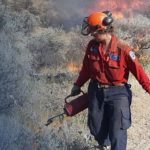Home »

Special Air Quality Statement issued
When there is fire, there is smoke. Even when the fires are hundreds of kilometres away.
Environment Canada has issued a ‘Special Air Quality Statement’ for the East Kootenay, as smoke drifts into the region from the west and north.
“Smoke is causing poor air quality and reducing visibility. Smoke is expected or occurring. The Ministry of Environment, in collaboration with the Interior Health Authority, has issued a Smoky Skies Bulletin for Kinbasket, North Columbia, West Columbia, East Columbia, Yoho Park – Kootenay Park, East Kootenay, West Kootenay, Elk Valley, Kootenay Lake, Arrow Lakes – Slocan Lake, Boundary, the Cariboo, Chilcotin, North Thompson, South Thompson, Shuswap, Okanagan, Similkameen, Fraser Canyon and Nicola regions, because of forest fire smoke that is covering the area,” the Environment Canada statement outlined, adding, “Smoke concentrations will vary widely as winds, fire behaviour and temperatures change.”
The statement offers tips in the event smoke gets thick.
Avoid strenuous outdoor activities. If you are experiencing any of the following symptoms, contact your health care provider: difficulty in breathing, chest pain or discomfort, and sudden onset of cough or irritation of airways. Exposure is particularly a concern for infants, the elderly and those who have underlying medical conditions such as diabetes, and lung or heart disease.
a) In most fire seasons, there are occasions when smoke from forest fires is carried into our region.
b) Under these conditions, smoke concentrations may vary dramatically over short periods and over small distances.
c) Those members of the public who are sensitive to the effects of smoke should monitor their symptoms and, if necessary, take steps to reduce their exposure to smoke.
d) During the fire season, a heavy bluish-white haze, possibly accompanied by the smell of smoke, are clear indications that smoke concentrations are higher than usual. The concentrations and air quality health index measured at an air station many kilometres away may not be a good indication of local smoke conditions.
Individuals may experience symptoms such as increased coughing, throat irritation, headaches or shortness of breath. Children, seniors, and those with cardiovascular or lung disease, such as asthma, are especially at risk.
Stay inside if you have breathing difficulties. Find an indoor place that’s cool and ventilated. Using an air conditioner that cools and filters air may help. If you open the windows you may let in more polluted air. If your home isn’t air-conditioned, consider going to a public place (library, shopping mall, recreation centre) that is air-conditioned.
This bulletin will remain in effect until further notice.
For more information on current air quality, see: www.bcairquality.ca .
Visit www.airhealth.ca for information on how to reduce your health risk and your personal contribution to pollution levels, as well as for current and forecast AQHI values.
e-KNOW







